Tag Archives for " trex decking "
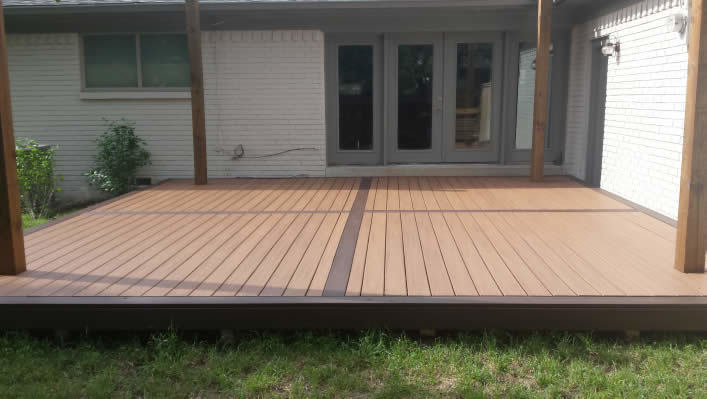
Trex vs Pressure-Treated Pine Decking Comparison Guide
Using Trex vs pressure-treated pine decking material means making several considerations. How much do you want to spend? Are you building a pool deck or a balcony deck? Maybe you would like a small patio deck or a large deck for your business. No matter what you are building your deck for, there are a few obvious (and not so obvious) considerations you need to make regarding functionality, longevity and other important factors.
If you use Trex as opposed to pressure-treated pine to build your deck, how long will it last? Is the extra cost involved in your up-front Trex investment worth it, or should you spend less initially for a pressure-treated pine deck? Which deck material requires more maintenance and money over time? Is one type of material better for the environment, and what do you need to know about fire rating and weather-resistance?
While the hard facts and statistics about building a deck are certainly important, there is an emotions-based question you need to ask yourself first, and that is …
… What Do You Want Your Deck to Do?
Whether you want a patio deck, pool surround or balcony deck, you have certain expectations. Some folks build a backyard deck to entertain. They need their deck to provide reliable functionality that will allow them to host parties and create wonderful memories for years or decades. What you want from a pool deck is excellent water-resistance and a deck that won’t get too hot for your friends and family entering and exiting the pool.
If you are making a deck to showcase your skills as a backyard barbecue expert, you need quick and easy clean-up and stain-resistance. All these considerations mean you should know exactly what you want your deck to do. How will you be using your deck? For instance, pressure-treated decking can be used for a pool or hot tub surround, while Trex works fine in both of those applications also. Comparing a Trex vs pressure-treated pine deck begins with knowing what type of experience you are trying to create. Then you can begin an initial and long-term cost comparison.
Trex vs Pressure-Treated Pine Cost, Now and Down the Road
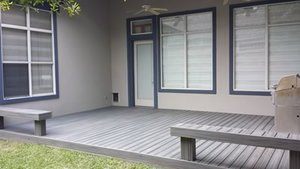
Trex Deck
Trex is the name of a composite deck material. It is also the name of the manufacturer that makes this combination of wood fibers and recycled plastic. A Trex deck will run about $26 to $36 per square foot to build, and that includes labor and materials. Pressure-treated decking will cost somewhere in the neighborhood of $14 to $20 per square foot installed. As you can see, this makes treated lumber a rather attractive financial choice over Trex.
Your home was not a “one and done” purchase, and your deck isn’t either. You have to set aside money for ongoing maintenance and upkeep or your home will suffer from neglect. The same is true with your deck. Since the materials are very different, comparing Trex vs pressure-treated pine will show significant cost differences for annual and long-term maintenance.
A Trex deck can last longer than a pressure-treated deck but will require annual cleaning. A pressure treated pine deck will also require cleaning and also a good weather sealant every 1-5 years depending on the brand of stain / weather sealant used. This means the composite construction of Trex allows for much less maintenance and upkeep than treated lumber. You can expect to spend more time, elbow grease and money taking care of your pressure-treated pine deck.
Trex does not require staining or painting. Once your Trex decking gets acclimated to your environment, the resulting color will stay the same without any painting, finishing or staining.
Pressure Treated Pine (aka PTP) lumber has a much lower up-front installation cost than Trex, but will require more effort and money to maintain over time.
Trex vs Pressure-Treated Pine Durability – How Long do You Want Your Deck to Last?
Some homeowners will build a basic pressure-treated deck before they list their home for sale. The low cost addition gives the home a higher perceived value than without the deck. If you are climbing the corporate ladder and don’t expect to be in your current home for more than a few years, a pressure-treated pine deck might make the most financial sense.
A PTP deck can look great with regular maintenance and upkeep for a several years, while costing less to build than a Trex deck. Treated decks are perfect for DIY homeowners that like spending their free time on home improvement projects. Why pay more for a Trex deck if you look forward to staining or sealing your deck every year or five and cleaning it frequently?
On the other hand, the durable Trex decking products carry 25 year warranties. In many cases these decks last more than 25 or 30 years. You can expect 10 to 25 years good use from a pressure-treated deck, depending on how regularly you maintain the deck and what your local climate and environment is like. The entire Trex vs pressure-treated pine deck cost comparison can be broken down for you by consulting an experienced deck builder. Call a deck builder with decades of experience making beautiful, durable decks in your area for a free, in-depth construction and maintenance cost breakdown.
Pressure-Treated Deck vs Trex Decking – Insect, Fire and Weather Resistance
The functionality and wonderful memories you get from your deck will depend largely on durability. You want decking material that is going to be unattractive to hungry bugs. Knowing the deck you build will effectively resist the effects of sun, rain and other aspects of weather is also important. You certainly don’t want a fire hazard on your hand. Both types have a man made resistance to bugs.
When a deck is built at ground level it would be best to use (ground contact) PTP but for longevity of either, then air flow (air space underneath deck) is recommended to keep them aired out and dry. Just as important is to have proper drainage underneath, meaning no standing water.
Consider the Fire Rating
Trex decking material carries a Class C fire rating. This is the minimal fire rating suggested by independent consumer safety organization Underwriters Laboratories (UL) for use in building products in and around the home. This is also known as a Class III fire-resistance rating. Many of the materials used to build your home carry this exact same fire rating.
Pressure-treated pine contains chemicals and preservatives which protect your deck against rot and decay. This pressurized treatment also resists fungi, termites and other wood-chomping bugs. Pressure-treated southern yellow pine also carries a class C fire rating. But you can spend more for Dricon FRT wood or there are a number of types of fire retardant that can be applied to slow fire spread rating.
Will Your Deck Resist Hungry Bugs?
As we just mentioned, pressure treated southern yellow pine (PTP) has a chemical used in the pressurization process that it is resistant to termites and other bugs or insects that bore into wood. Trex decking materials also carry an insect resistant label, and their combination of recycled plastic materials and wood fibers make them unappealing to the crawly creatures that eat wood.
If you choose pressure-treated pine or Trex decking materials, both will resist insect infestation and rot. However, there is a point that needs to be made here. You will need to diligently seal your pressure-treated deck every years in order to help the wood retain insect resistance. This maintenance factor is not needed with Trex decking products.
Are Pressure-Treated Pine and Trex Decking Weather-Resistant?
A Trex deck is resistant to fading. We mentioned earlier that your Trex deck requires no ongoing staining, painting or finishing to hold its color. If you are in an extremely sunny and hot environment, you may notice gradual fading after 10 or 15 years with Trex materials. In many cases there is no significant change in coloration over the lifetime of the deck.The exterior coating (capped) of Trex decking materials repels water.
Pressure-treated pine will definitely fade over time. You can delay this affect with a regular coat of weather sealant / stain that also repels water. Concerning weather conditions such as rain or snow, Trex is going to hold up better over time than pressure-treated decking materials. In the short-term, your deck will look great and function properly during normal exposure to weather whichever of these two decking materials you choose to use.
Looks Aren’t Everything … Oh Yes They Are!
It is probably safe to make the assumption that you want your deck to look good. No one wants to build an addition onto their house or in their backyard that looks trashy or downright ugly. When deciding on Trex vs pressure-treated pine as a deck building material, how your deck looks is not going to vary much for the first couple of years.
The difference happens down the line. The process which combines recycled plastics and wood fibers into the composite decking material (Trex) is a more costly procedure than simply pressure treating southern yellow pine. The process makes for a sturdy and long-lasting deck material that may not lose its color for 15 or 20 years.
The same is not true for pressure-treated wood. The appearance of PT pine deck materials will reflect how diligently you stain and seal your deck. If you don’t spend time on maintenance and upkeep with a pressure-treated pine deck, it is going to reflect that negligence. The benefit of a Trex deck is that once you choose a color and build your deck, you are going to get the same look and appearance for years and years without staining or sealing.
This isn’t to say that pressure-treated decks can’t be beautiful. Some people choose a natural wood over composite decking material because the beauty of nature really comes out when that wood is stained and sealed. It requires more upkeep and elbow grease to keep a pressure-treated deck looking good than it does with a Trex deck, but many homeowners don’t mind the extra annual maintenance.
This means your financial cost for the periodic maintenance of your pressure-treated deck will be greater than with a Trex deck, but your upfront building cost is much more attractive. You shouldn’t forget that a Trex deck will change slightly in its color and shade the first 2 to 3 months after installation. This happens because the decking material has to get used to your environment, but the change is gradual in nature. After that, the color shouldn’t fade for several years, and even then only gradually.
Trex vs Pressure-Treated Pine Safety Considerations
The safety of your deck comes down to a number of factors. If people are acting irresponsible and running on a wet pool deck, they may fall and become injured. This is in most cases not the fault of the decking material, but rather the person who was injured. Pressure-treated yellow pine and Trex are rot and decay resistant for a number of years. This means the likelihood of someone stepping through your rotted deck floor or falling because a railing gave way is not likely to happen.
The yellow pine which is used for many pressure-treated decks has a natural texture which makes it resistant to slipping. You can choose Trex products with textured finishes that make them highly resistant to slipping as well. As far as all-around safety goes, a Trex deck is a much more hands-off maintenance choice than pressure-treated decking. With either choice, you are responsible for sweeping and cleaning your deck and keeping it free of debris which could act as safety hazards.
For general safety concerns, you will be happy with pressure-treated wood or Trex decking materials.
Pressure-Treated vs Trex Decking – Which is Better for the Environment?
Trex decking materials are made up of 95% sawdust, recycled wood fibers and plastic materials. This keeps waste products out of landfills. It should also be noted that the Trex company has formed a partnership with the US Forest Stewardship Council. This guarantees your Trex deck was built with no materials that came from an endangered rain forest.
Caring for a PTP deck requires staining and/or painting every year or two. This means it is up to you to handle, store and dispose of these chemicals correctly so you don’t negatively impact the environment. Trex does not require a weather sealant or staining.
Comparing Trex vs pressure-treated pine reveals that a PTP deck that can last as long as a Trex deck but this can also mean that more yellow pine trees must be grown and harvested for you to replace individual decking materials like balusters and deck boards, or if you want to replace your entire deck. Most pressure-treated lumber is EPA approved, and both Trex and pressure-treated deck materials are environmentally friendly when disposed of properly.
To get a more accurate comparison of both for your application contact a seasoned pro for a no obligation quote.
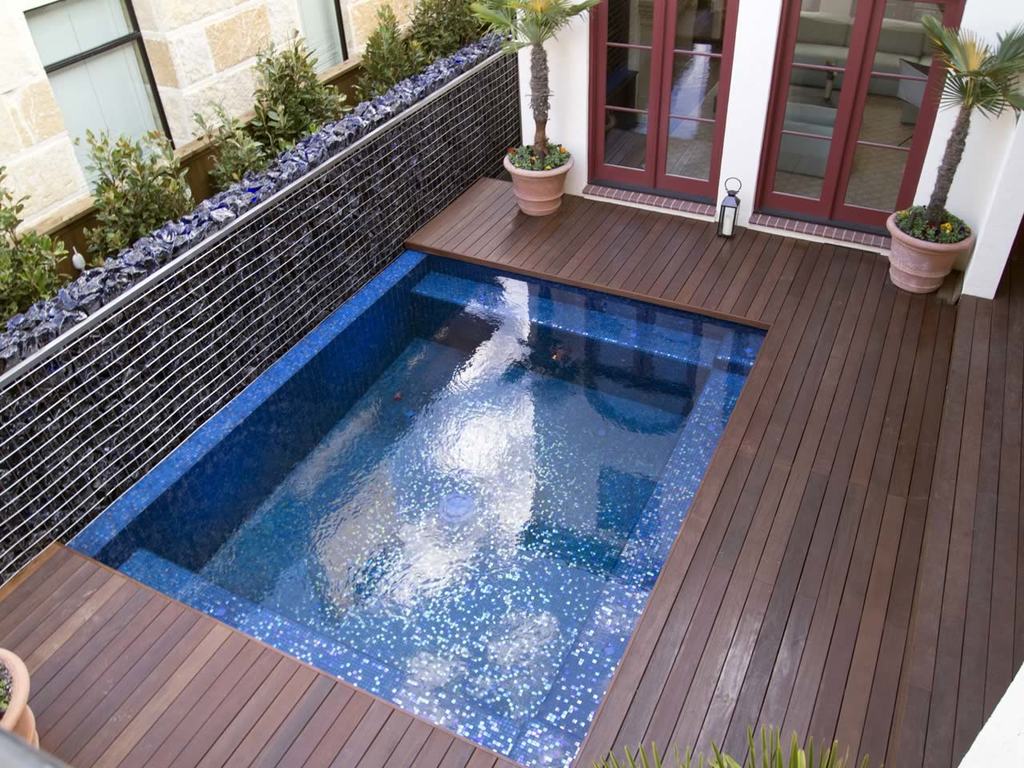
Ipe vs Trex Decking Comparison Guide
So you are considering a new deck but not sure if you should go with ipe or Trex? In this article we will point out the qualities and differences so that it can help with your decision. When comparing ipe against Trex decking, cost may be the first thing that comes to mind. Even if you have a large budget you don’t want to overpay for your deck. Good looks is certainly a consideration, and durability comes into question as well. Of course, you should understand maintenance responsibilities and costs for your deck project, and remember that cost is not just an upfront issue. There may be financial costs attached to long-term maintenance.
While you certainly want to consider all of these factors, there is a big question you should answer first before you weigh the pros and cons of ipe (pronounced EE-pay) and Trex decks. Regardless of your budget, the size of the deck you are looking for and any other aspect of this project, you need to ask yourself the following question.
How Will You Be Using Your Deck?
Are you looking to build a pool deck? Choosing the right type of decking material can help you provide a slip-free surface that keeps your swimming friends and family members safe. Bare feet are synonymous with a swimming pool experience, so you want to select a type of wood or composite that doesn’t get too hot in the blazing sun.
Perhaps you are building a deck as a retreat. You want a place you can go to get away from the hustle and bustle of your busy life. Maybe you enjoy entertaining. You love playing the host, and you want to design a decking area where you can create great memories with your loved ones. Of course, if you fancy yourself a 5-star outdoor chef, you can use your deck to display your backyard grilling skills.
Think long and hard about what experience you want your deck to provide for you. Once you know the physical and emotional needs you expect your outdoor deck to give you, you can move on to other ipe versus Trex considerations.
For instance, Trex can get hotter to the touch than ipe, so it might not be the best choice for a pool surround. On the other hand, Trex can be a little less expensive upfront than ipe and it is available in colors not found in natural woods. To continue your decking comparison, let’s talk money.
Ipe vs Trex Cost, Now and Down the Road
Whatever type of deck you build, it is going to require maintenance. You have an upfront cost for construction that includes parts and labor. Once your dream deck is created it may be a beauty to behold, but that beauty depends on you if it is going to last. This means that even with the most durable, weather-resistant, hands-off deck is going to come with maintenance considerations.
Maintenance means money. Cleaning products and stains have financial costs, and so does elbow grease. If you are going to be the one maintaining your beautiful deck, you have to consider how much your time is worth. This means knowing what you should expect as an upfront construction cost. Average annual maintenance cost is also important before you decide on ipe over Trex, or vice versa.
Ipe is a “real wood” created by Mother Nature and it is incredibly dense. If you prefer to let it patina to a beautiful gray then it doesn’t have to be stained or sealed. Have you ever seen teak wood used on a boat? It will also weather out if not oiled.

Newly installed, raw ipe.

Ipe after 6-8 months with no oil.

Ipe after 15-20 years with no oil.
On the other hand if you would like to retain the beautiful natural colors then you would need to have it oiled on an annual basis. Ipe is so tightly constructed by nature that stains, sealers and oil cannot penetrate past the outer layer of the wood very well.

Newly installed ipe deck with oil being applied.
Your initial cost for ipe decking materials will most likely be higher than those of Trex products. This is in part because it is imported from Central and South America. Also there is only so much ipe in the world. It has to be grown and responsibly harvested.

Trex is a manufactured product that combines recycled plastic and wood. This makes it a little less expensive. Composite decking materials are not as strong as ipe (aka ironwood), so it requires a little more attention to the framework when installing.
On an annual maintenance basis, a 12′ x 20′ ipe deck may carry an average annual maintenance cost of $480 for cleaning and oiling, while the same size Trex deck can set you back $240 or more per year on average for cleaning cost.

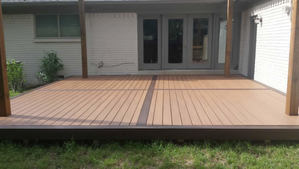
Ipe vs Trex Durability: How Long do You Want Your Deck to Last?
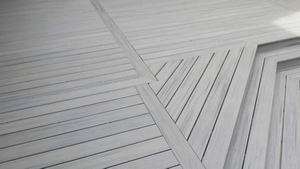
Ipe is a natural hardwood that is found mainly in Brazil. Trex is a composite decking material made from mostly recycled wood and plastic. Incidentally, Trex is also the name of the company that manufactures this decking product. Due to their physical makeup, ipe and Trex respond differently to Father Time, exposure to sunlight and other factors.
Ipe lasts forever. Not really, but it sure seems that way. Ipe decking has been used at Disneyworld and on the Atlantic City Boardwalk in New Jersey because it lasts so long. Its low-maintenance, high-density resistance to pounding feet and weather compared to other deck types is why you can expect 25 to 50 years of longevity on most ipe products. Some ipe decks can last 50 to 75 years or longer when they are taken care of.
That’s right… your ipe deck may outlive you!
This is not to say that Trex materials don’t last. They certainly do. Trex backs their decking products with a 25 year warranty. If you take care of your Trex deck, you can expect it to look great and provide wonderful memories for 25 to 30 years.
What the Heck is the Janka Hardness Scale?
Comparing ipe vs Trex means understanding how hard they are. The oddly named Janka scale measures how hard different natural woods are. Named after Austrian Gabriel Janka, it is often used to compare how hard decking materials are, thereby giving you an idea of how resistant they are to wear and weather.
The Janka hardness rating for ipe is 3,680, which is 8 times harder than that of a California redwood tree. Trex decking materials are not nearly as hard as ipe. This does not mean they aren’t durable, as is evidenced by the accompanying 25 year warranty. Trex does not carry a Janka rating, but it should be fine for your backyard deck.
You want to choose a hardness level like that of ipe or some other dense hardwood if you are going to have extremely high levels of traffic and wear, like in the Disneyland and Atlantic City Boardwalk examples from earlier. For a residential application, you can expect years of beauty and durability from either ipe or Trex decking products.
Consider Your Deck Material Fire Rating
A fire rating comparison of decking products shows that Trex decking materials are recommended as safe for residential applications. Many of the products in your home, including the building materials that were used to build your home, carry the Class C fire rating of Trex decking products. Also referred to as a Class III rating, this classification comes from Underwriters Laboratories, an unbiased and independent consumer safety organization.
Ipe woods have earned a Class A (Class I) fire rating. This means they are also safe and acceptable for residential applications such as building your deck. Because this wood is so dense and tightly packed, it is much harder for it to catch fire with a very low fire spread time when compared to other natural woods and composite decking products. And for this reason ipe is accepted for most commercial applications.
Keeping the Bugs at Bay
A comparison of ipe vs Trex decks would not be complete without discussing the insects and bugs that may view your deck as a tasty treat. You probably also want to know that your resident woodpecker won’t be able to drill holes in your deck when he is looking for bugs to eat. In both cases, Trex and ipe decking materials are more insect-resistant than many natural and composite woods.
Trex is sold as insect-resistant and ipe is noted for being insect-resistant. Because Trex boards are a combo of wood and plastic, they are less than appealing to the bugs that chomp on wood. The natural ipe wood repels insects because it is too hard for them to chew or bore into. Both are winners here.
Rain, Sun, Snow and Other Weather Considerations
Time and weather will eventually destroy anything, whether man-made or natural. Will the sun fade a Trex deck? The answer is yes… after a considerable amount of time. Trex is a composite decking type, and this means it is resistant to fading. However, if your Trex deck receives strong, direct sunlight most of the year, it’s color may begin to fade. This will only happen after 10 or so years, and the fading is gradual, not all at once.
An ipe deck will naturally fade over time. It will eventually develop a silver-grayish patina. The special ipe oil finish mentioned earlier can help your Ipe deck maintain a beautiful, natural appearance. As was previously discussed, these oils need to be applied on an annual basis to keep the original look of the wood.
If your deck builder does his job properly, he will talk about the natural tendency for a Trex deck to gradually change its color over the first 2 to 3 months after it has been built. This is a normal occurrence which happens as your deck adjusts itself to your environment. It might be a good idea to take a look at an existing Trex deck in your area so you can picture the very slight change in color will occur.
As far as rain, snow and other weather conditions that can physically impact your deck, Trex and ipe both do a good job resisting their effects. Both are mold and splinter-resistant, both clean up easily after a storm, and both are highly weather-resistant.
What Do Trex and Ipe Decks Look Like?
Trex comes in several colors. Ipe gives you what Mother Nature created. This means your ipe deck will have boards with varying shades and hues of a rich reddish brown. There are amber and cherry red influences as well. If you have an obsessive compulsive disorder, you are going to want to choose Trex vs ipe, since the color will be consistent from one board to the next.
Since Trex decking materials are man-made, you can choose one of the many colors available and every board will match its partner. Trex color variations include descriptive names like Spiced Rum, Gravel Path, Tiki Torch and Lava Rock.
We talked earlier about how ipe will eventually develop a silvery, gray finish. This by no means will happen immediately. You can expect a year or so of use out of your ipe deck before the natural grayish patina will begin to develop. With Trex decking you can expect the same look 5 or 10 years down the road as you get after the initial 8 to 12 week color change takes place.
Safety Factors to Think About When Comparing Ipe vs Trex
Does comparing ipe vs Trex mean one is a safer product than the other? Since both products are durable and long-lasting, it is hard to say that one is going to provide more safety than the other. If you want your deck to be built out of one of the hardest woods on the planet, one that is virtually fire, rot and bug-resistant, choose the more expensive ipe.
That having been said, the construction of Trex decking materials makes them unattractive to insects and other bugs that bore into wood. Trex and ipe are resistant to decay, which lends obvious safety factors. This means a safe decking product, as the structural integrity of the deck is kept intact.
Ipe is one of a limited number of decking choices that gets the thumbs-up from the American Disabilities Act. It is actually so anti-slippery that it surpasses the standards and requirements the American Disabilities Act (ADA) demands for its safety seal of approval. It is highly slip-resistant, even when wet. Trex decking is available in slightly textured finishes that make it slip-resistant as well.
Consider the Environmental Impact
Arguing ipe vs Trex scores some environmentally conscious points for both sides. Ipe lasts so long that repair and replacement costs are virtually nonexistent. This means that less ipe wood needs to be harvested over time to build these durable, beautiful decks. Since an ipe deck can literally look great and keep its functionality for 50 or more years, there is less of an environmental impact than caused by the 15 to 25 year longevity of pressure-treated pine decks. Ipe wood is also chemical-free.
Trex decks are environmentally responsible as well. Trex is made from 95% recycled wood fibers, sawdust waste and recycled plastic materials. Additionally, Trex works hand-in-hand with the US Forest Stewardship Council to ensure the decking materials they offer didn’t come from an endangered rain forest. The same is true for many ipe manufacturers, so be sure to ask your deck builder if his ipe products are FSC-approved when you request a free quote.
